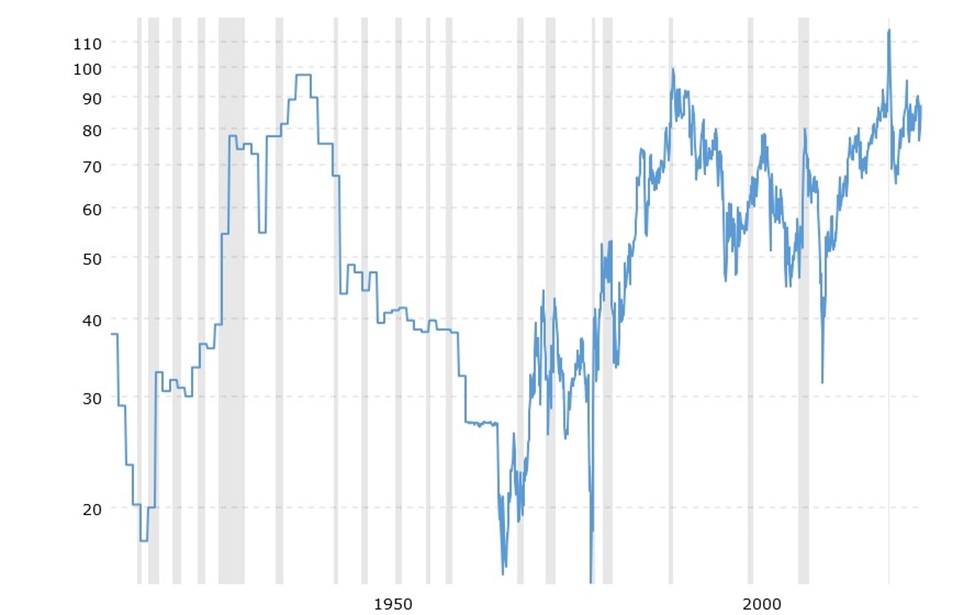The Irritating Fallacy of the Gold-Silver Ratio
The gold-silver ratio has long been a hallmark of market analysis, particularly among those who cling to the notion that the interplay between gold and silver prices provides insight into broader economic trends. Historically, the ratio has been considered a guidepost for investment decisions, with some analysts claiming that it provides clues about inflation, deflation, or even impending market crashes. Other analysts watch the ratio and trade the underlying commodities, on a bet the ratio will ‘return to normal’.
In today’s financial landscape, the gold-silver ratio is increasingly being seen as a relic of the past—an obsolete metric clung to by those who fail to recognize the complexities of modern markets. In many ways, the persistence of belief in the gold-silver ratio mirrors the themes explored in Isaac Asimov’s award-winning Foundation series, where outdated systems of belief and control eventually crumble in the face of technological and intellectual progress.
(And let’s admit it. We’ve all read Foundation.)
The Gold-Silver Ratio: A Dinosaurs’ Fallacy
The gold-silver ratio, in its most basic form, is a simple calculation of how many ounces of silver it takes to buy one ounce of gold. This ratio has fluctuated but has often hovered around 15:1 to 20:1 due to both metals’ role as money in ancient economies.

https://www.macrotrends.net/1441/gold-to-silver-ratio
Today, the ratio is far more volatile, sometimes exceeding 80:1 or even 100:1, reflecting the increasingly divergent push/pulls for these metals. The chart above for the past 100 years shows that volatility and no ‘normal’.
As the chart shows, to the modern investor the current relevance of the gold-silver ratio is dubious at best. While gold continues to hold its place as a traditional store of value, silver’s role has shifted significantly. Silver is not only an investment commodity and used in jewelry, it is also an industrial metal, heavily used in solar panels, electronics, and medical devices. The idea that these two metals should be linked in any meaningful way, based on a centuries-old ratio, is akin to believing that the economic principles governing the Roman Empire still apply in the modern, technology-driven world.
The Fallacy in Foundation: Hari Seldon’s Psychohistory
The Foundation series offers an illuminating allegory for why clinging to outdated economic theories, like the gold-silver ratio, is futile. In the series, Hari Seldon creates the science of psychohistory, which allows him to predict the future of entire civilizations through the laws of mathematics and probability. His predictions are precise, but they are based on the assumption that human behavior, over time, is largely predictable as long as the humans do not know their behaviour is being predicted. As the series unfolds, unforeseen variables begin to disrupt the deterministic nature of his equations, throwing his predictions into question. Once the humans learn their behaviour is being predicted, they change their behaviour, making their behaviour unpredictable.
In much the same way, the gold-silver ratio represents a kind of financial “psychohistory,” where past relationships between two metals are assumed to predict future trends. However, the modern market is full of unforeseen variables—advances in technology, changing industrial demands, geopolitical shifts—that render the ratio meaningless. The notion that this ratio can continue to offer value in today’s complex financial systems is an illusion, much like Seldon’s belief that psychohistory could account for all of humanity’s future behavior.
The Rise of Modern Metrics: Beyond Gold and Silver
Just as the Foundation evolves beyond Seldon’s predictions, modern financial analysis must evolve beyond simplistic ratios like gold-silver. Today, investors rely on more nuanced metrics, including macroeconomic indicators, inflation forecasts, interest rate trends, sector-specific supply-demand dynamics, and government interventions. For instance, silver’s growing demand in green technologies like solar panels and electric vehicles introduces complexities that the traditional ratio cannot capture. Similarly, gold’s role as a hedge against economic instability has become more multifaceted, shaped by everything from global central bank policies to digital assets like cryptocurrencies.
The gold-silver ratio, in this context, is a relic. It offers a snapshot of a bygone era when both metals played similar roles in economies. Today, their paths have diverged so significantly that using this ratio as a predictive tool is akin to clinging to outdated religious beliefs in the face of overwhelming scientific progress—a theme Asimov explores in Foundation as well. In the story, the fall of the Galactic Empire represents the inevitable failure of those who refuse to adapt to a changing world. The same can be said for investors who continue to rely on the gold-silver ratio as a cornerstone of their analysis.
The future belongs to those who can adapt, leaving behind the dinosaurs of outdated market metrics.